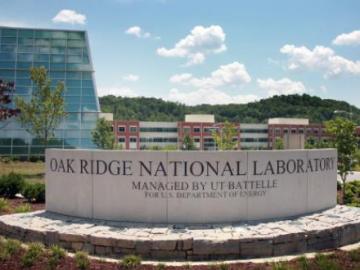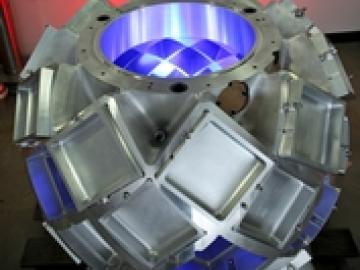Robert Hettich: Decoding biological complexity with next-gen mass spectrometry
Filter News
Area of Research
- Advanced Manufacturing (34)
- Biological Systems (18)
- Biology and Environment (180)
- Biology and Soft Matter (5)
- Building Technologies (12)
- Chemical and Engineering Materials (4)
- Chemistry and Physics at Interfaces (11)
- Computational Biology (6)
- Computational Chemistry (5)
- Computational Engineering (5)
- Computer Science (19)
- Data (1)
- Electricity and Smart Grid (3)
- Energy Frontier Research Centers (14)
- Energy Science (525)
- Energy Sciences (5)
- Fossil Energy (3)
- Fuel Cycle Science and Technology (3)
- Functional Materials for Energy (16)
- Fusion and Fission (55)
- Fusion Energy (19)
- Geographic Information Science and Technology (3)
- Isotope Development and Production (3)
- Isotopes (36)
- Materials (434)
- Materials Characterization (2)
- Materials for Computing (36)
- Materials Synthesis from Atoms to Systems (13)
- Materials Under Extremes (12)
- Mathematics (1)
- National Security (81)
- Neutron Data Analysis and Visualization (4)
- Neutron Science (212)
- Nuclear Science and Technology (75)
- Nuclear Systems Modeling, Simulation and Validation (3)
- Nuclear Systems Technology (1)
- Quantum Condensed Matter (4)
- Quantum information Science (9)
- Reactor Technology (1)
- Sensors and Controls (5)
- Supercomputing (318)
- Transportation Systems (11)
News Type
Date
News Topics
- 3-D Printing/Advanced Manufacturing (142)
- Advanced Reactors (40)
- Artificial Intelligence (124)
- Big Data (77)
- Bioenergy (108)
- Biology (124)
- Biomedical (72)
- Biotechnology (35)
- Buildings (73)
- Chemical Sciences (84)
- Clean Water (32)
- Composites (33)
- Computer Science (223)
- Coronavirus (48)
- Critical Materials (29)
- Cybersecurity (35)
- Education (5)
- Element Discovery (1)
- Emergency (4)
- Energy Storage (114)
- Environment (217)
- Exascale Computing (64)
- Fossil Energy (8)
- Frontier (62)
- Fusion (65)
- Grid (73)
- High-Performance Computing (128)
- Hydropower (12)
- Irradiation (3)
- Isotopes (62)
- ITER (9)
- Machine Learning (66)
- Materials (156)
- Materials Science (155)
- Mathematics (12)
- Mercury (12)
- Microelectronics (4)
- Microscopy (56)
- Molten Salt (10)
- Nanotechnology (62)
- National Security (85)
- Neutron Science (169)
- Nuclear Energy (121)
- Partnerships (66)
- Physics (68)
- Polymers (34)
- Quantum Computing (51)
- Quantum Science (87)
- Security (30)
- Simulation (64)
- Software (1)
- Space Exploration (26)
- Statistics (4)
- Summit (70)
- Transportation (102)
Media Contacts

Thermal energy in ordinary crystal materials takes the form of tiny atomic vibrations that ripple through the material in waves. Instead of spreading evenly through the material, some of the energy will clump into little packets. Scientists had thought that these energy packets, which they call intr...

In a breakthrough for neutron science, scientists used a 30 Tesla pulsed magnet and the powerful pulsed neutron beam at the Spallation Neutron Source to probe the magnetic behavior of the multiferroic material manganese tungstate. (A multiferroic material has both electrical and magnetic properties....

A special report highlights the accomplishments of researchers running large, complex and often unprecedented simulations on Department of Energy Office of Science supercomputers. The research community gains access to these powerful machines through the Innovative and Novel Computational Impact on ...

Five of the world's most advanced instruments for neutron scattering research are serving the neutron science community following the completion of the $68.5 million SING project at Oak Ridge National Laboratory's Spallation Neutron Source (SNS).

A novel microscopy method at the Department of Energy's Oak Ridge National Laboratory is helping scientists probe the reactions that limit widespread deployment of fuel cell technologies.

To study questions of why the universe has matter, physicists can try to create another ?Big Bang' somewhere and study how it evolves. If they only do it once, however, like flipping a coin, there is bias. So they must run a few thousand ?Big Bangs' and wait 14 billion years for each one and see how...

Nano-sized palladium particles elevate the performance of a new hydrogen microsensor to an unprecedented level, according to Oak Ridge National Laboratory's Nickolay Lavrik. The key innovation is based on the fact nano-sized palladium particles react very quickly to hydrogen gas. "Our hydrogen senso...

Researchers at Oak Ridge National Laboratory are making new functional nanocomposite materials by inserting nanoparticles into asymmetric block copolymer films, resulting in promising new matrices on which such materials can be constructed. The Magnetism Reflectometer at ORNL's Spallation Neutron So...

Oak Ridge National Laboratory managing contractor UT-Battelle has donated $25,000 to an effort to honor the memory of Alvin M. Weinberg, the Department of Energy national laboratory's first director who was recognized as a nuclear pioneer and science visionary.

William Brinkman, director of the U.S. Department of Energy's Office of Science, joined officials from DOE and Oak Ridge National Laboratory on Tuesday to dedicate a new Chemical and Materials Sciences Building.


